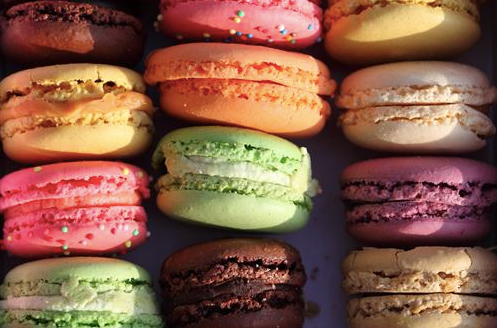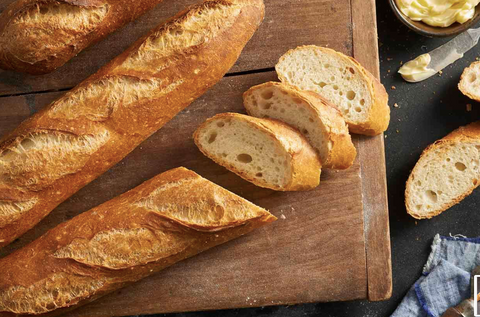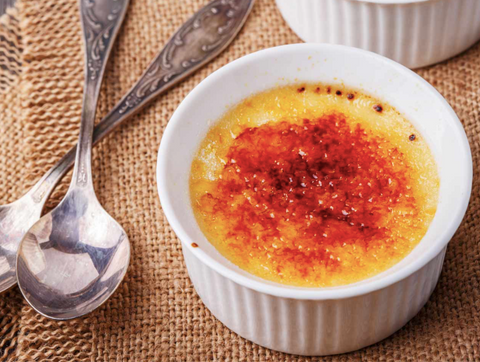France has always been a leader in the culinary industry. They're well-known for their pieces of bread, cheeses, and gourmet cuisine, and they've made considerably more contributions to the food industry than you might think. They mastered a wide range of difficult dinners, created a wide range of wines and Champagnes, and, most importantly, created some of the world's most delectable and lovely desserts. The French have a reputation for being dessert connoisseurs. French cakes can have layers of ganache, pastry cream, pâte à choux, mousse, puff pastry, jam, whipped cream, meringue, and more in addition to cake and buttercream. With recipes ranging from simple and sublime to elaborate and opulent, these exquisite French cakes provide an excellent introduction to the world of gateaus and madeleine.
13 Fabulous Types of French Cakes
1. Baba Au Rhum
A yeast cake soaked in rum-based syrup is known as a rum baba or baba au rhum (originally they were soaked in a sweet fortified wine). Individual servings (approximately a 5 cm tall, slightly tapered cylinder) are the most popular, but larger shapes, similar to Bundt cakes, are also possible. After the cake has been made, it is soaked in rum (hence the name). Baba Au Rhum is wonderful on its own, but with whipped cream or pastry cream on top, it's even better. The dried fruits would fall out of the cakes after soaking in the wine sauce for a day. Eggs, milk, and butter are all used in the baba batter.
In Poland and France, Baba is known as Babka. The word baba means "falling over or dizzy" in French. In France, the dish became quite popular. The cake is known as Savarin in various parts of the world. This cake is known as "father's cake" in Turkey.
2. Buche de Noel
Yule Log Cake is another name for Buche de Noel, a traditional Christmas cake. The name of the cake (Buche de Noel) comes from the centuries-old tradition of burning Yule logs on Christmas Eve. The cake is in the shape of a yule log, as the name suggests. Despite its French beginnings, this cake has grown in popularity around the world.
A thin chocolate cake is rolled with buttercream or whipped cream filling in the original recipe. It's topped with marzipan leaves or meringue mushrooms and finished with chocolate buttercream to imitate tree bark. Buche de Noel is traditionally decorated with confectioners' sugar to resemble snow on a Yule log. There are an endless amount of flavor combinations available in modern variations.
The Buche de Noel is tastefully garnished and arranged, resembling a ready-to-burn log. Marzipan sticks, sugar cobwebs, and meringue mushrooms might all be used as decorations. A buttercream filling and Genoise or other sponge cake is used in this classic supper. Chocolate cakes have been utilized in the past for this purpose.
- Madeleine
The Madeleine cake is a French national favorite that is little, delicious, and easy to create. This shell-shaped pastry has been passed down through the generations, and its origins, like the croissant, are unknown. In any case, the fundamental cake is one of France's best, created with equal parts butter, sugar flour, eggs, and grated lemon peel.
There are various stories concerning who was the first baker to produce these. They are supposed to have been designed by a teen girl in King Stanislas of Lorraine's court. When a chef refused to cook dessert in a fit of passion, she stepped in, and the King and his guests were so taken with the small cakes the maid created that they christened them Madeleine.
According to numerous stories, they were made by Jean Avice, a well-known pastry chef who worked with Prince Talleyrand (1754-1838). Avice is credited with inventing Madeleine by making small cakes with aspic molds. According to another legend, they were prepared by Queen Marie, Louis XV's wife, with the assistance of her cook Madeleine.
- Far Breton
Far Breton is a typical French dessert made of prunes, eggs, raisins, flour, and milk baked into a custard flan cake similar to clafoutis. The cake is a Brittany delicacy, with a recipe dating back to the 18th century when it was served as a savory accompaniment to meat courses.
Several recipes call for soaking the dried fruits in alcohol; while this isn't a conventional method, it does give the dish a distinct flavor. Custard from Far Breton is frequently served with a significantly more "burned" appearance than online recipes suggest; the custard's top appears nearly blackened rather than golden brown. With the addition of additional butter and eggs, Far Breton became an expensive dessert throughout time. During the period, it was mostly consumed by the aristocracy. The cake is still one of the most popular French family sweets today.
- Financier
A financier is a small almond cake with a beurre noisette flavor that is baked in a small size. The typical financier is light and moist on the interior with a crunchy, eggshell-like outside, and is created of egg whites, flour, and powdered sugar. Molds are often small rectangular loaves, akin to petits fours in size. The cakes are built and sculpted to resemble golden bricks or lingot as they are known in French.
This dessert was created by a pastry chef named Lasne in the nineteenth century. He made this moist sponge cake and shaped it to look like a brick of gold because most of his clients were brokers who didn't want to stain their fingers. The name financier is thought to have come from a conventional rectangular mold that looks like a gold bar. According to another legend, the cake became popular in Paris' financial district, particularly near the Paris stock exchange, because it could be easily stored in one's pocket without harming it.

- Fiadone (Cheesecake)
Brocciu (fresh whey cheese made from goat's or ewe's milk), eggs, sugar, lemon zest, and lemon juice make up Fiadone, a typical Corsican dessert. It's also referred to as the Corsican cheesecake. Oranges can be substituted for lemons on occasion, and the base can be supplemented with local liqueurs. The cake used to be a classic Christmas dessert and a staple meal for many special occasions, but it is now served all year. Its wonderful plain, with honey poured on top or with fruit preserves or fresh fruit on top. The Corsican fiadone is quite similar to ricotta fiadone and other comparable Italian desserts.
- Kouign-Amann (Sweet Pastry Cake)
Kouign-Amann is a French cake that dates back to the 1800s and originated in the French province of Bretagne. Its name comes from the Breton terms kouign and butter (cake and butter) (Amann). Layers of sugar and butter are folded into the dough to make the cake. Because of its flaky golden crust and ample amounts of sugar and butter, Bretons claim that the cake is "the fattiest pastry in the world." The most prevalent theory regarding the cake's origins is that it was accidentally created when a 19th-century baker from Douarnenez tried to preserve a defective batch of dough by adding butter and sugar to the mix, resulting in the delicacy we know today.
8. St. Honoré Cake (Gateau Saint-Honore)
This delightful treat, which bears the name of Saint Honoré, the patron saint of bakers in France, is a true embodiment of French confectionery excellence. Puff pastry, vanilla custard, choux pastry, and caramelized sugar make up the Saint Honoré cake.
Miniature cream puffs dipped in caramelized sugar are topped with a large amount of custard piped onto a puff pastry foundation. Despite being invented in the nineteenth century, this delicacy is still one of France's most popular sweets. This show-stopping dish is normally saved for rare occasions, festivals, and festivities because it takes so much time and effort to prepare. Modern versions of the original incorporate exotic tastes and tropical fruits, but the vanilla-flavored Saint Honoré cake remains the most popular.
9. Galette des rois (Koningentaart, Galette Parisienne)
This traditional French dessert is most often associated with northern and central France, and it is one of many king cakes prepared and served on Epiphany, the Christian feast celebrating the arrival of the Three Wise Men in Bethlehem on January 6th.
A thick layer of frangipane, an almond-based pastry cream, is sandwiched between two layers of buttery puff pastry to make the cake. Whoever finds a fève (a porcelain or plastic lucky charm) buried inside the frangipane is crowned queen or king for the day, according to mythology.
This masterpiece was known as gâteau de l'égalité during the Revolution, which is surprising given how unpopular royalty was at the time. In most French bakeries, galettes are now sold with a symbolic paper crown pasted to the top. A dessert comparable to this is Koningentaart, which is popular in Belgium and the Netherlands.

- Fraisier
Fraisier is a strawberry-flavored French cake named after the term fraise in French. Layers of genoise sponge, vanilla-flavored créme mousseline, marzipan, and lines of fresh, sliced strawberries are used to make the cake. Fraisier was created as a tribute to strawberries because the only strawberries available in France before the 19th century were tiny wild strawberries that were similar in size to blueberries. New varieties of strawberries became accessible for use in sweets in France and the rest of Europe in the 1930s, and a new dish was born.
11. Charlotte Russe (Charlotte Cake)
This cake began as a sponge cake pressed into a pleasing shape and filled with thick custard or crème Bavaroise flavored with cooked fruit, spices, or brandy in 18th-century France. The dish is supposed to have been created by Marie-Antoine Carême, a brilliant French chef recognized as the "Father of French Cuisine."
In his 1815 book The Royal Parisian Pastry Cook and Confectioner, Carême named his cake Russe in honor of his Russian boss, Czar Alexander I, and included a recipe for Charlotte à la Russe (formerly Charlotte à la Parisienne). The exquisite Charlotte Malakoff is one of the various variations of this delicious dessert that have evolved through time. It is filled with kirsch-flavored almond cream and topped with Chantilly cream and berries.
When French and British forces defeated Russia in the Crimean War in 1855, this version was born. A ladyfinger cake filled with custard, mousse, or whipped cream and fruit purée is the modern Charlotte.
The so-called Charlotte Royale, which has the same filling as Charlotte Russe but replaces the ladyfinger lining with Swiss roll slices, is another popular variation to Charlotte Russe. Charlotte russe is frequently adorned with jelly and other fruits, resulting in an aesthetically magnificent and tasty dessert worthy for the Czar.
12. Dacquoise (Le Biscuit Dacquois)
For a crisp and creamy texture, this traditional French cake is created consisting of layers of almond or hazelnut meringue sponge cake divided by whipped cream or buttercream. The cake's name comes from the French word dacquoise, which refers to a town in southern France. Dacquoise, on the other hand, is a name that now refers to any dessert that comprises layers of nut meringue sponge cake.
The cake is said to have been made in the 17th century as a lavish treat for the people of the French court. After many french cooks moved to England to cook for the upper crust, the dish became well-known. The famous Marjolaine is a rectangular version of dacquoise that is considered the mother of all French desserts. It is comprised of meringue sponge cake with chocolate butter cream.
13. Petit four
Petit fours are little sweet or savory confections or appetizers. The term "petit four" refers to a small oven. Mignardises is a term for a variety of small pastries sold in a French bakery, whereas petits fours are a term for hard, buttery biscuits. Petits fours come in three different flavors:
- Glacé ("glazed"), frosted, or ornamented fondant or icing-covered tiny cakes, such as French éclairs and tartlets.
- Salé appetizers, which are popular at cocktail parties and buffets.
- Snack-size biscuits, baked meringues, macarons, and puff pastries.




